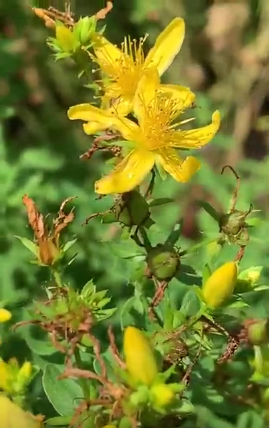Learn about St. John’s wort benefits and watch the plant being harvested in the Clearpath garden. It will be made into topical oil
In the video below you can see the flowers and leaves of St. John’s wort, Hypericum perforatum, being harvested. The flower and the upper leaves are the medicine. The plant gets its name “perforatum” because the leaves have tiny white specs in them that make it look like they’re perforated.
St John’s wort is one of those celebrity herbs. Most people know it for its internal antidepressant use. It is even more renowned in the herbal world for its ability to heal damaged nerves and to rejuvenate nerves internally. St. John’s wort is also an excellent antiviral herb.
St. John’s wort benefits users as a potent topical oil
Today we’re not harvesting St. John’s wort for internal medicine, but we’re taking it to make oil for topical use.
Hypericin is the main active ingredient, along with hyperforin. Even though St. John’s wort flowers are brilliantly yellow, when you make oil out of it, the color becomes a deep red. That’s the medicine. We’re going to be using these flowers to make an infused oil with extra virgin olive oil for topical nerve and skin medicine, not internally for its antidepressant medicine.
One contraindication for external or internal use is that for some people in the summertime exposed to a lot of light, you can develop a kind of photo dermatitis reaction to the plant. This is why a lot of people who take it internally choose to take it during the winter and the darker months. These people then let it go for the brighter months, especially if they’re outside a lot.
St. John’s wort benefits for burns
Laura described an experience with St. John’s wort where she had touched the hot engine of a lawn mower, leading to an intense burn and severe pain. After eight hours of excruciating pain, she used St. John’s wort oil on the burn and it took away the pain. The next morning the skin was already starting to heal. St John’s wort provided a quick response as an excellent topical medicine.
In the video you can see a close-up of the flowers in three stages. One is in its full flower phase with five petals. Then there are buds that haven’t gotten to flower yet. Then there are flowers that have gone past the ideal state for harvesting and are starting to produce seeds.
So we are harvesting the prime flowers and the buds that are about to open. We’ll collect enough to put into a mason jar. We will infuse the flowers with extra virgin olive oil and let this sit for a few weeks. Then we will gently decant and press it out. You don’t want to press it too much because that will lead to collecting a lot of the watery material and not just the pure oil. We also don’t make too much oil at a time because it does not have a very long shelf life. We aim to collect enough to last the year so we can then harvest more the following year.
Do you use St. John’s wort? What has your experience with this plant been like?
Interested in becoming an herbalist?
The first online herbal medicine course from Clearpath School of Herbal Medicine, Foundations of Western Herbalism, Part 1 , begins with a systematic and comprehensive exploration of human beings and human health through the lenses of Western/European and First Nations/Native American health modalities while also interweaving principles and practices with contemporary scientific and medical understanding.
Learn more about this online herbalist course here. You can watch an introductory video and take a deeper look at the information you will learn from this course.

